ORGANISED agricultural enterprise in Zimbabwe can be traced back as far as the 14th century Munhumutapa Kingdom, which subsisted between AD 1430 and AD1760.
Agriculture remains one of the most important pillars in contemporary Zimbabwe’s economic structure.
-
Land & Climate
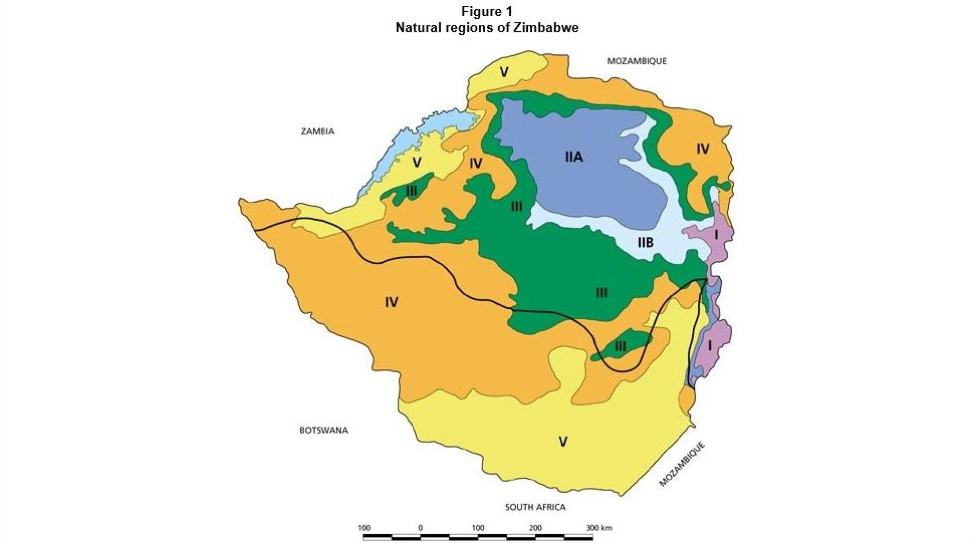
Zimbabwe is a landlocked country in the Southern Africa region, with an area of over 390 000 km2. It is bordered by Zambia, Mozambique, South Africa and Botswana. It is situated between 15 and 22° south latitude and 26 and 34° east longitude. Climatic conditions are largely sub-tropical with one rainy season, between November and March. Rainfall reliability decreases from north to south and also from east to west. Only 37 percent of the country receives rainfall considered adequate for agriculture.
| Natural Region |
Area (km2) | % of total | Rainfall Characteristics |
| I | 7 000 | 2 | More than 1 050 mm rainfall per year with some rain in all months. |
| II | 58 600 | 15 | 700 – 1 050 mm rainfall per year confined to summer. |
| III | 72 900 | 18 | 500 – 700 mm rainfall per year. Infrequent heavy rainfall. Subject to seasonal droughts. |
| IV | 147 800 | 38 | 450 – 600 mm rainfall per year. Subject to frequent seasonal droughts. |
| V | 104 400 | 27 | Normally less than 500 mm rainfall per year, very erratic and unreliable. Northern Lowveld may have more rain but topography and soils are poorer. |
| Total | 390 700 | 100 |
Natural Region I is a specialised and diversified farming region. The region is suitable for forestry, fruit and intensive livestock production. Smallholders occupy less than 20 percent of the area of this region.
In Natural Region II flue-cured tobacco, maize, cotton, sugar beans and coffee can be grown. Sorghum, groundnuts, seed maize, barley and various horticultural crops are also grown. Supplementary irrigation is done for winter wheat. Animal husbandry like poultry, cattle for dairy and meat, is also practiced. Smallholder farmers occupy only 21 percent of the area in this productive region.
Natural region III is a semi-intensive farming region. Smallholders occupy 39 percent of the area of this region. Large-scale crop production covers only 15 percent of the arable land and most of the land is used for extensive beef ranching. Maize dominates commercial farm production. The region is subject to periodic seasonal droughts, prolonged mid-season dry spells and unreliable starts of the rainy season. Irrigation plays an important role in sustaining crop production.
Natural regions IV and V are too dry for successful crop production without irrigation, but communal farmers have no other choice but to grow crops in these areas even without access to irrigation. Millet and sorghum are the common crops but maize is also grown. Communal farmers occupy 50 percent of the area of Natural Region IV and 46 percent of the area of Natural Region V.
Source: Ministry of Agriculture, Lands and Resettlement
-
Economic significance
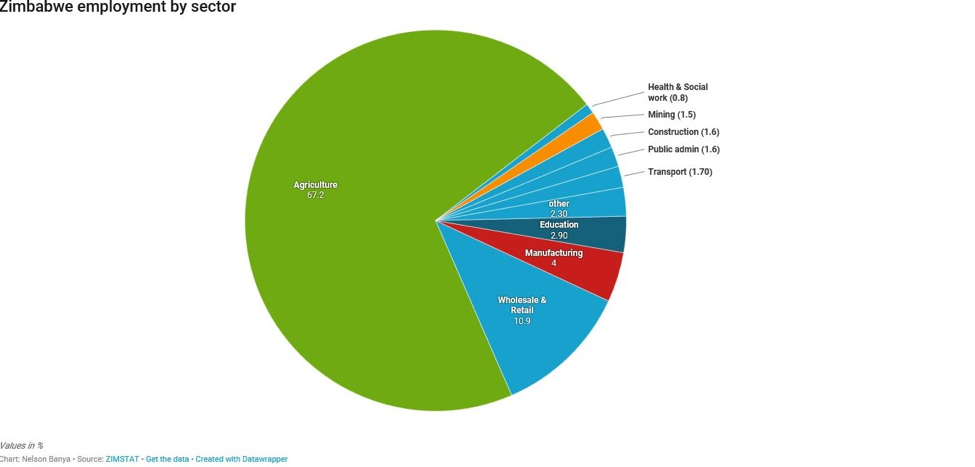
https://datawrapper.dwcdn.net/HWVHd/1/
Zimbabwe’s economy remains anchored on agriculture, despite upheavals following the ‘fast-track’ land redistribution programme which started in 2000. At its peak, the sector contributed a third of Zimbabwe’s gross domestic product, but this figure has gone down to the 10 percent to 15 percent range. Agriculture provides employment for nearly 70 percent of the economically active population, according to the 2014 Zimstat Labour Force Survey. The sector accounts for 60 percent of all raw materials used by the manufacturing sector and contributes about 45 percent of total export earnings.
- Major sub-sectors
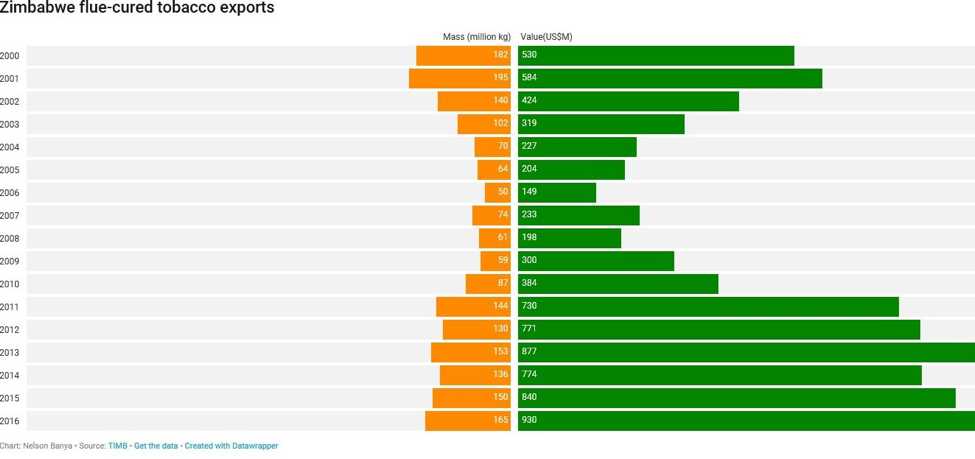
Tobacco
https://www.datawrapper.de/_/yqoWJ/
Tobacco is Zimbabwe’s main export crop, recording $898,8 million in sales in 2018, down from $913,8 million in 2017, according to data from the Tobacco Industry and Marketing Board.
The crop contributes 15 percent to GDP and 25 percent to total exports, according to the Zimbabwe Tobacco Association.
At its peak, Zimbabwe produced 236 million kilogrammes of tobacco in 2000. Output fell to 48 million kilogrammes in 2007/2008 at the height of Zimbabwe’s political and economic crisis.
In 2017, output was put at 180 million kilogrammes.
For the 2017/2018 cropping season, 103 429 growers are registered to produce the crop.
Maize
Maize is Zimbabwe’s staple cereal, produced in most of the country’s ecological regions.
According to government statistics, Zimbabwe’s annual human cereal consumption stands at 1 568 725 tonnes. Cereal consumption by livestock stands at 350 000 tonnes, giving total cereal requirements of 1 918 725 tonnes in 2017.
In the 2016/17 season, total cereal production (maize, sorghum, pearl and millet) was 2 443 119 tonnes, with maize making up the bulk, with 2 155 526 tonnes.
Here is Zimbabwe’s historical maize production:
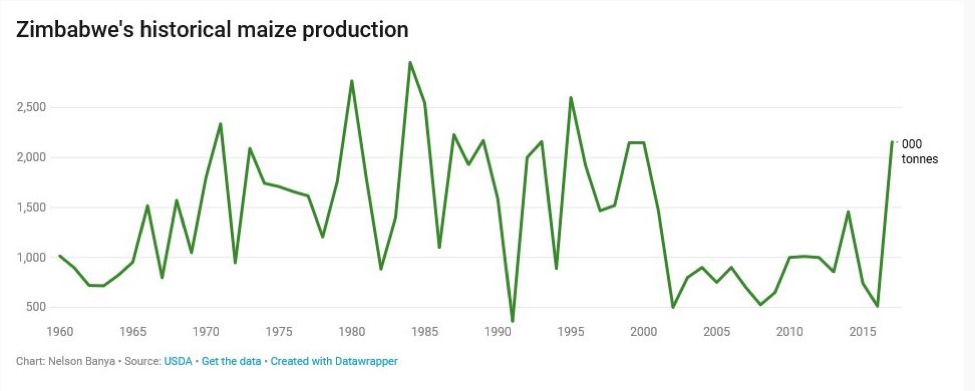
https://www.datawrapper.de/_/qgihz/
Other crops and livestock
Zimbabwe’s diversified agriculture sectors has several other crop and livestock products, see graph below:
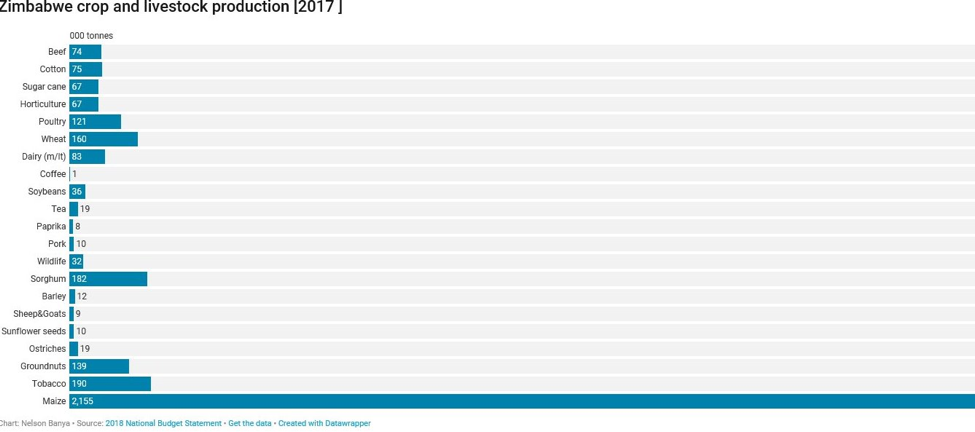
https://datawrapper.dwcdn.net/9Xq8g/1/
Factsheet compiled by Nelson Banya
Do you want to use our content? Click Here









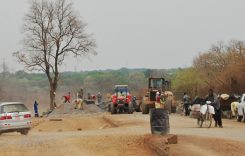


Dominic Magwada
- Edit
Very useful. A planners tool kit !
Prof S Mpepereki
- Edit
1. Irrigation: Actual and potential; water sources: area covered by sector (large & small scale).
2. Mechanization by sector (tractors & equipment): Large scale (LS); medium (A2), Small scale (A1; communal).
3. Agricultural exports: is it only tobacco?
Anonymous
- Edit
U could also tell the places in the regions
V Tight gel
- Edit
Hi there,
Firstly, bunch of thanks for sharing such valuable information with us.
Actually i was doing some research about Zimbabwe agricultural industry and latest development. & i get landed over your article, it is really informative.
Thank you
Source: https://myeveschoice.com/
Anonymous
- Edit
Temperature range
Anonymous
- Edit
Thank you for sharing this info.
I would like also if have any information on Zimbabwe percentages of self sufficient in these crops and horticulture produce.
Thank you.
Anonymous
- Edit
Thank you for sharing this info.
I was wondering if you could provide any information on Zimbabwe percentages of self-sufficiency in these crops and horticulture produce.
Thank you.
Anonymous
- Edit
This helped me out